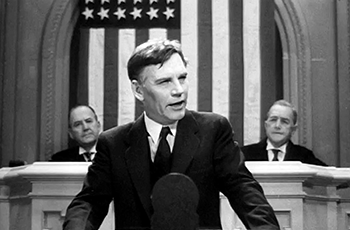
AUTOCRACY ON FILM – GABRIEL OVER THE WHITE HOUSE
Judson Hammond is a fictional American president, whose political party is not named. The party expects their “boy” to do what they want him to do. A near-death experience changes Hammond. He wakes from a coma determined to do the greatest good for the greatest number, even if it means firing the cronies in his cabinet, dismissing Congress, declaring a national emergency and imposing martial law. For movie audiences both weary and fearful after years of the Great Depression and rampant gang warfare, a movie about a political leader who assumes authoritarian control—seemingly to benefit the populace—struck a chord. For some, that chord was hope; for others, a serious warning about the precarious fate of democracy.
Lesson Material:
Supplemental Film Clips:
"Taking the Oath of Office"
"The Oval Office"
"Dictatorship or Patriotism"
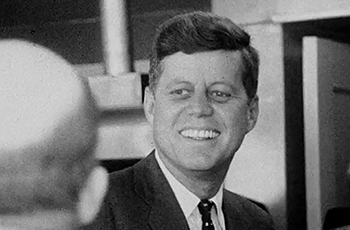
CINEMA VERITÉ – FILMING JOHN F. KENNEDY
In 1960, documentarian Robert Drew approached two presidential candidates, Hubert Humphrey and John F. Kennedy, seeking permission to film them on the campaign trail. He proposed making a movie with minimal narration, relying instead on candid footage of the candidates as they interacted with voters. He argued that the documentary would be a record of history. Both candidates agreed to have Drew and his team film them during the final days before the primary election in Wisconsin.
In this lesson, students screen two video interviews about John F. Kennedy. The first features Robert Drew explaining his approach to covering Kennedy during the Wisconsin primary election in 1960. The second is with historian Richard Reeves, who discusses how Kennedy changed the imagery associated with the office of the President.
Lesson Material:
Supplemental Film Clips:
"Robert Drew Discusses Primary"
"Tracking Shot From Primary"
"Richard Reeves Interview"
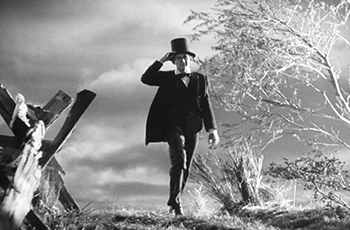
CONTRASTING CINEMATIC DEPICTIONS OF LINCOLN
In this lesson, students identify and interpret cinematic depictions of Abraham Lincoln as expressed through two highly acclaimed biographical movies: John Ford’s Young Mr. Lincoln (1939) and Steven Spielberg’s Lincoln (2012). Ford’s film focuses on Lincoln as a young lawyer in Illinois, years before he would run for public office. Spielberg’s movie focuses on the last few months of the president’s life and his efforts to pass the 13th Amendment abolishing slavery and involuntary servitude. Students will screen and analyze scenes from both movies and comment on the contrasting depictions.
Lesson Material:
Supplemental Film Clips:
"Changing Horses Mid-Stream"
"Top of the Hill"
"Lincoln's Dream"
"The Fate of Human Dignity"
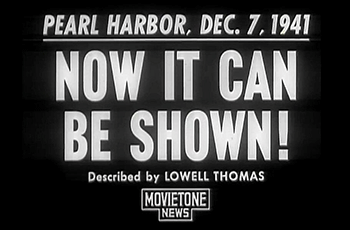
Critical Thinking and Viewing: The Propaganda Newsreel, 1942
On June 13, 1942, six months after the United States entered the Second World War, President Franklin Roosevelt signed Executive Order 9182, establishing the Office of War Information (OWI). The OWI’s key objective was to mobilize the country for all-out war. This meant controlling the information Americans received about the war effort, both on the battlefronts and on the home front. In an era long before social media and 24/7 television news, newsreels were an essential source of information and a critical means of communicating with Americans.
This lesson introduces students to the use of propaganda in newsreels and asks them to consider the following two questions: How might a movie become a weapon of war? When might propaganda be useful in preserving democracy?
Lesson Material:
Supplemental Film Clips:
"Now It Can Be Shown"
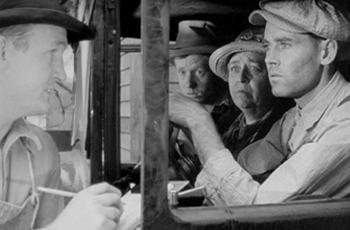
Critical Thinking and Viewing: The Grapes of Wrath
This lesson on critical thinking and viewing is from "Portraits of America: Democracy on Film," a comprehensive curriculum using classic movies to explore ideals and challenges of our society.
Lesson Material:
Supplemental Film Clips:
"Red River Valley" from The Grapes of Wrath (1940, d. John Ford)
"Ma's Memories" from The Grapes of Wrath (1940, d. John Ford)
"Crossroads" from The Grapes of Wrath (1940, d. John Ford)

HAROLD LLOYD'S THE FRESHMAN
The activities in Harold Lloyd’s The Freshman (1925, directed by Sam Taylor and Fred Newmeyer) help students discover how to decode this silent film comedy, practicing their inference skills as they learn to identify nuances of meaning within the moving images. The lesson also explores the historical and cultural context of the film -- college life in the 1920s.
Lesson Material:

Exploring Chinese Cinema (Grades 5–8)
The stories the world tells through film transcend news of current events and help us to understand the many ways people are alike, despite the barriers of language and political and religious ideology. The U.S. shares a rich cinematic history with other countries. This shared heritage is a foundation on which our countries can build a relationship of cultural understanding, one that will directly affect the youth of each nation.
Film is a powerful and visual language. It is also a universal language. The International Film Classroom was developed by The Film Foundation in cooperation with IBM and the United States Department of State. The program engages middle and high school students in the study of exceptional foreign films.
The goals of these teaching units are:
- to increase awareness of and appreciation for foreign and American culture through meaningful film study in the classroom;
- to initiate relationships and to promote ongoing partnerships between arts and educational institutions both in the United States and in foreign countries;
- to introduce students to foreign language film study, providing visual literacy skills to assist in reading and interpreting moving images of other cultures.
Although these films are quite different in content and cinematic style, each reflects China’s changing society. The Film Foundation and its Chinese partners selected these films based on the following criteria: age-appropriate content, excellence in filmmaking, and educational value.
This unit is intended as an introduction only and not as an in-depth study of China or China’s rich film heritage. Each lesson has multiple activities that can be taught over 3–5 days. The lessons are interdisciplinary in approach, both reinforcing and challenging students’ knowledge of literature, history, geography, art and music.
Featured film lesson:
The King of Masks (1996, directed by Wu Tianming)
Teachers will need a DVD copy of the film to correspond with the written lesson material. The King of Masks may be rented or purchased for use in the classroom.
Lesson Material:
Exploring Chinese Cinema (Grades 7–12)
The stories the world tells through film transcend news of current events and help us to understand the many ways people are alike, despite the barriers of language and political and religious ideology. The U.S. shares a rich cinematic history with other countries. This shared heritage is a foundation on which our countries can build a relationship of cultural understanding, one that will directly affect the youth of each nation.
Film is a powerful and visual language. It is also a universal language. The International Film Classroom was developed by The Film Foundation in cooperation with IBM and the United States Department of State. The program engages middle and high school students in the study of exceptional foreign films.
The goals of these teaching units are:
- to increase awareness of and appreciation for foreign and American culture through meaningful film study in the classroom;
- to initiate relationships and to promote ongoing partnerships between arts and educational institutions both in the United States and in foreign countries;
- to introduce students to foreign language film study, providing visual literacy skills to assist in reading and interpreting moving images of other cultures.
Although these films are quite different in content and cinematic style, each reflects China’s changing society. The Film Foundation and its Chinese partners selected these films based on the following criteria: age-appropriate content, excellence in filmmaking, and educational value.
This unit is intended as an introduction only and not as an in-depth study of China or China’s rich film heritage. Each lesson has multiple activities that can be taught over 3–5 days. The lessons are interdisciplinary in approach, both reinforcing and challenging students’ knowledge of literature, history, geography, art and music.
Featured film lesson:
Beijing Bicycle (2001, directed by Wang Xiaoshuai)
Teachers will need a DVD copy of the film to correspond with the written lesson material. Beijing Bicycle may be rented or purchased for use in the classroom.
Lesson Material:
Exploring Chinese Cinema (Grades 9–12)
The stories the world tells through film transcend news of current events and help us to understand the many ways people are alike, despite the barriers of language and political and religious ideology. The U.S. shares a rich cinematic history with other countries. This shared heritage is a foundation on which our countries can build a relationship of cultural understanding, one that will directly affect the youth of each nation.
Film is a powerful and visual language. It is also a universal language. The International Film Classroom was developed by The Film Foundation in cooperation with IBM and the United States Department of State. The program engages middle and high school students in the study of exceptional foreign films.
The goals of these teaching units are:
- to increase awareness of and appreciation for foreign and American culture through meaningful film study in the classroom;
- to initiate relationships and to promote ongoing partnerships between arts and educational institutions both in the United States and in foreign countries;
- to introduce students to foreign language film study, providing visual literacy skills to assist in reading and interpreting moving images of other cultures.
Although these films are quite different in content and cinematic style, each reflects China’s changing society. The Film Foundation and its Chinese partners selected these films based on the following criteria: age-appropriate content, excellence in filmmaking, and educational value.
This unit is intended as an introduction only and not as an in-depth study of China or China’s rich film heritage. Each lesson has multiple activities that can be taught over 3–5 days. The lessons are interdisciplinary in approach, both reinforcing and challenging students’ knowledge of literature, history, geography, art and music.
Featured film lesson:
Kekexili: Mountain Patrol (2004, directed by Lu Chuan)
Teachers will need a DVD copy of the film to correspond with the written lesson material. Kekexili: Mountain Patrol can be rented or purchased for use in the classroom.
Lesson Material: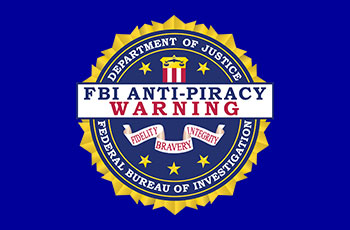
The Film Piracy Problem
A Problem-Solving Activity recommended for students in grades 8–12.
What we have in America is a whole generation of consumers who believe that because material is available on the Internet, that it’s free and fair game. . . . I have a 23-year-old son who has this mindset. He and his friends don’t believe it’s wrong to, in effect, steal copyrighted material.
—LeVar Burton, Director
Recent developments in digital technology make file sharing on the Internet convenient and relatively fast, and have contributed significantly to the film piracy problem. This teaching unit introduces students to the technology, as well as to U.S. copyright laws, which protect the creative works of artists.
The Film Piracy Problem includes both a teacher’s guide with lesson plans and glossary, as well as student reading and research activity sheets. To complete the problem-solving process, students must tap their knowledge of multiple subject areas, including math and social studies. The teacher’s guide provides a cross-curricular applications chart.
Lesson Material: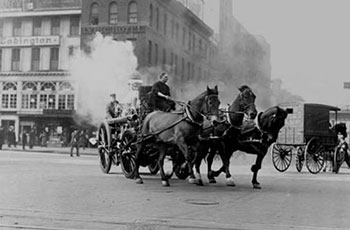
INTERPRETING A SHORT DOCUMENTARY FILM
The Library of Congress began collecting films, including many of those produced by Thomas Edison, in the 1890s. Many of these early motion pictures were not traditional narratives but rather actuality films that documented the American way of life at the beginning of the twentieth century. They are valuable historical and cultural resources. Today, the Library of Congress houses thousands of films within its archives. This activity introduces students to this rich repository of early motion pictures. Students research, then screen one of the short documentary or actuality films from the Library of Congress collection. This activity challenges students’ chronological thinking and historical comprehension skills, while at the same time integrating social studies/history with language arts.
Lesson Material:
WRITING ABOUT HISTORY USING MOVING IMAGES
This lesson introduces students to archival collections of documentary videos from the early 1900s through the 20th century. Students select a video for study. They analyze the historical value of the video using document-based questions (DBQs), then write a short paper on their interpretations. The goal of this lesson is twofold: (1) to introduce students to the concept that history is argument, or interpretation, based on evidence; and (2) to show that moving images can be an effective tool for presenting evidence.
Lesson Material: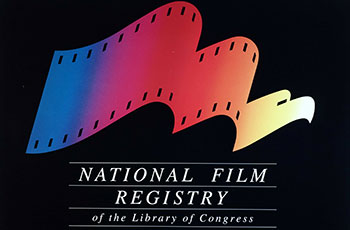
NOMINATING A FILM TO THE NATIONAL REGISTRY
Of the more than 21,000 feature-length films produced in the United States before 1951, less than half exist today. Seventy-five percent of all silent films no longer exist. To safeguard the country’s film heritage, the United States Congress passed the National Film Preservation Act in 1988. This law authorizes the Librarian of Congress to select up to 25 films each year for preservation. In this activity, students join the debate and nominate films of their choice to the National Film Registry. This activity provides an excellent real-world connection between your students and our country’s national library.
Lesson Material:
